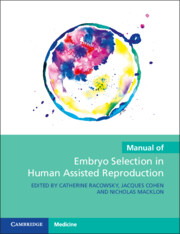Book contents
- Manual of Embryo Selection in Human Assisted Reproduction
- Manual of Embryo Selection in Human Assisted Reproduction
- Copyright page
- Contents
- Contributors
- Preface
- Chapter 1 Introduction
- Chapter 2 Embryo Developmental Programming
- Chapter 3 Embryo–Maternal Interactions
- Chapter 4 The Sperm’s Role in Embryo Development
- Chapter 5 The Oocyte’s Role in Embryo Development
- Chapter 6 The Laboratory’s Role in Embryo Development
- Chapter 7 Handling of Gametes and Embryos
- Chapter 8 Noninvasive Morphological Selection of Oocytes
- Chapter 9 Prospects for Bioenergetics for Embryo Selection
- Chapter 10 Static Morphological Assessment for Embryo Selection
- Chapter 11 Dynamic Morphological Assessment for Embryo Selection
- Chapter 12 Noninvasive Analysis of Embryo Nutrient Utilization for Embryo Selection
- Chapter 13 Genomics for Embryo Selection
- Chapter 14 Biopsy Techniques from Polar Body to Blastocyst
- Chapter 15 Cell-Free DNA Analysis for PGT-A
- Chapter 16 What Science May Come for Embryo Selection?
- Epilogue
- Index
- References
Chapter 15 - Cell-Free DNA Analysis for PGT-A
Published online by Cambridge University Press: 26 April 2023
- Manual of Embryo Selection in Human Assisted Reproduction
- Manual of Embryo Selection in Human Assisted Reproduction
- Copyright page
- Contents
- Contributors
- Preface
- Chapter 1 Introduction
- Chapter 2 Embryo Developmental Programming
- Chapter 3 Embryo–Maternal Interactions
- Chapter 4 The Sperm’s Role in Embryo Development
- Chapter 5 The Oocyte’s Role in Embryo Development
- Chapter 6 The Laboratory’s Role in Embryo Development
- Chapter 7 Handling of Gametes and Embryos
- Chapter 8 Noninvasive Morphological Selection of Oocytes
- Chapter 9 Prospects for Bioenergetics for Embryo Selection
- Chapter 10 Static Morphological Assessment for Embryo Selection
- Chapter 11 Dynamic Morphological Assessment for Embryo Selection
- Chapter 12 Noninvasive Analysis of Embryo Nutrient Utilization for Embryo Selection
- Chapter 13 Genomics for Embryo Selection
- Chapter 14 Biopsy Techniques from Polar Body to Blastocyst
- Chapter 15 Cell-Free DNA Analysis for PGT-A
- Chapter 16 What Science May Come for Embryo Selection?
- Epilogue
- Index
- References
Summary
It is well known that chromosomal abnormalities are among the major causes of implantation failure especially in patients at high risk of generating aneuploid embryos. Preimplantation genetic testing for aneuploidy (PGT-A) plays an important role in select patient populations for embryo selection by identifying euploid embryos. The current PGT-A technology involves analysis of trophectoderm (TE) cell biopsies removed from expanded blastocysts. However, when an embryo is mosaic, the chromosome copy number of the biopsied cells may not reflect that of the inner cell mass, thereby leading to false positive and false negative results. Recognizing these shortfalls of TE biopsy, studies have been undertaken to investigate the potential value of cell-free DNA (cfDNA) shed from the embryo as a more accurate reflection of the embryo chromosome copy number. Two approaches for acquiring such PGT-A samples have been investigated: collection of the blastocoelic fluid, and collection of the spent medium in which embryos were cultured. In this chapter, we focus on these two approaches, and present current findings supporting a potential role for each of these developing techniques for PGT-A. We highlight that blastocoelic fluid represents a valuable source of cfDNA, and that it provides important insight regarding blastocyst viability; and that while evidence for analysing cfDNA in spent medium holds promise, care must be taken to reduce the risk of maternal DNA contamination. We conclude that although both these approaches appear valuable in improving the sensitivity and specificity of PGT-A, clinical trials are required to evaluate their efficacy before being accepted into mainstream clinical IVF.
Keywords
- Type
- Chapter
- Information
- Manual of Embryo Selection in Human Assisted Reproduction , pp. 158 - 167Publisher: Cambridge University PressPrint publication year: 2023



